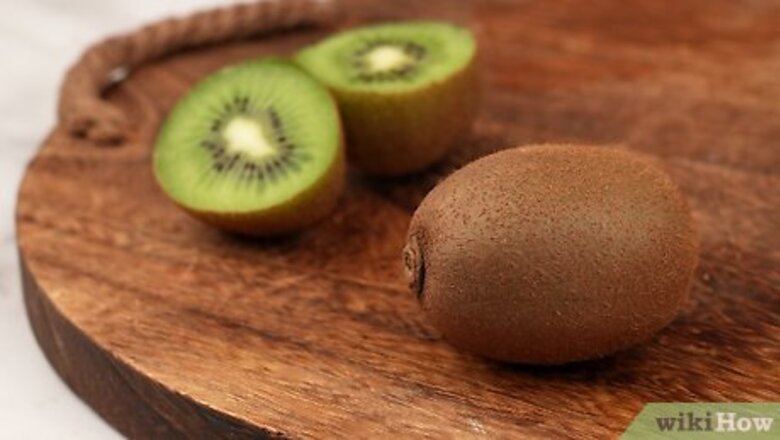
views
X
Trustworthy Source
Cleveland Clinic
Educational website from one of the world's leading hospitals
Go to source
Once you know how to determine whether a kiwi is ripe, this delicious green (or golden) fruit is easy to peel and prepare. You can eat it plain or try it as an ingredient in salads, smoothies and more.
Selecting a Kiwi
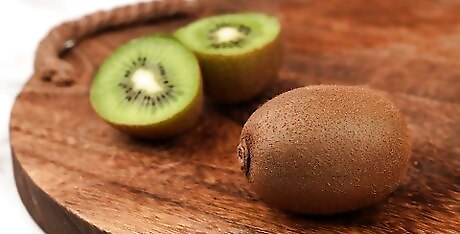
Check the kiwi for blemishes. Kiwi fruit has olive green or brown skin covered in a thin layer of fuzz. Inspect the kiwi all over to ensure it is has an even color on all sides. If you see spots that are darker in color or black, the kiwi may be rotten.
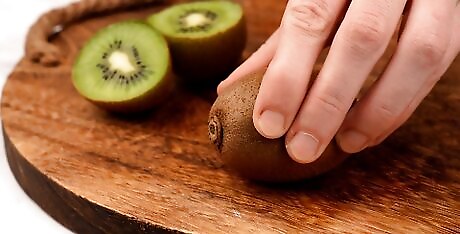
See if the kiwi gives slightly to the touch. A ripe kiwi is mostly firm, but it will give slightly when you press it with your thumb. This indicates that the kiwi has reached its peak of sweetness. If the kiwi is rock hard, it isn't quite ripe. You should be able to press it in slightly. If the kiwi gives too much, it is overripe. The kiwi should not feel mushy.

Smell the kiwi for signs of ripeness. A ripe kiwi will smell fruity and fragrant. The smell should be sweet, but not overpowering. If it verges on being sickeningly sweet, the kiwi is probably overripe. If it has no scent at all, it may not be ripe yet.
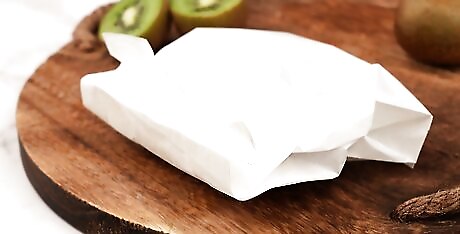
Learn how to ripen a kiwi. If the only kiwi fruit available is hard and underripe, you can ripen it on your kitchen counter at home. Simply place the kiwi fruit in a paper bag and leave it out at room temperature. In a day or two, it should be ready to eat. Kiwi fruit releases an enzyme that causes it to ripen. Storing it at room temperature in a paper bag speeds up the process. You can add a ripe apple or banana to make it go even faster. Don't try it with a plastic bag. It's important to have a little air circulation in the bag so that the kiwi doesn't end up tasting bad or rotting.
Peeling and Eating a Kiwi
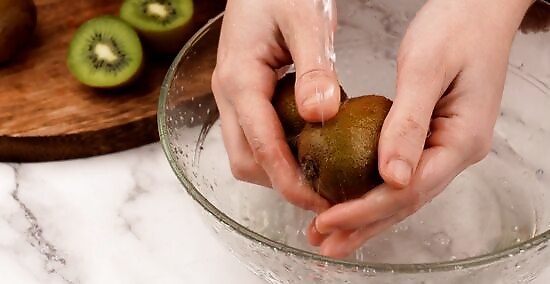
Rinse the kiwi. Place the kiwi fruit under cool running water to rinse away any dirt or debris. Even if it shows no visible dirt, it's a good idea to rinse the kiwi in case it was treated with pesticides. Dry the kiwi when you're finished.
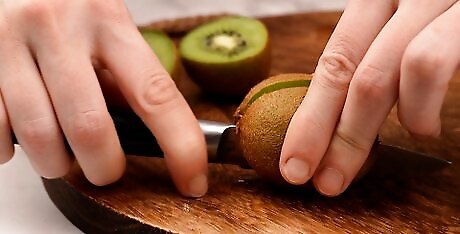
Slice the kiwi in half lengthwise. Stand the kiwi on one end. Use a paring knife to slice it down the middle, so the kiwi is split into two lengthwise halves.
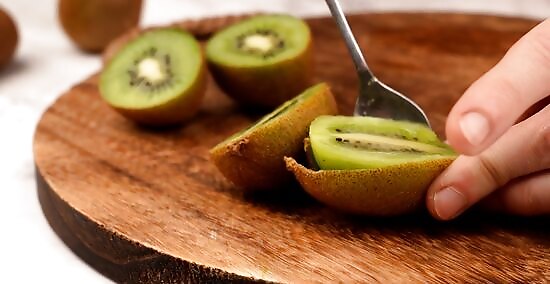
Scoop out the flesh with a spoon. If the kiwi is ripe, the flesh will come right out. Use the spoon to scoop close to the skin to separate it from the flesh. Do the same with both halves of the kiwi fruit. If the flesh won't come out easily, you may need to peel the kiwi with a paring knife. You can also use a vegetable peeler. You should also peel the kiwi if you prefer to keep it whole so that you can slice it into discs.
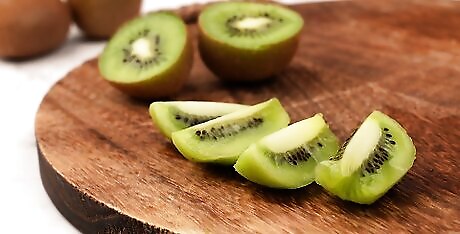
Eat the kiwi. You can eat the kiwi halves as is, or slice them into smaller pieces first. Fresh, ripe kiwi has a delicious taste with hints of both strawberry and citrus. Many people enjoy it plain, but if you're interested in trying a recipe with kiwis, they complement many other flavors well.

Store leftover kiwi in the refrigerator or freeze it. Kiwi fruit will keep for a day or two when kept covered in the refrigerator. After that, it will begin to break down and lose its delicate flavor. If you want to preserve your kiwi fruit for a longer period of time, freezing is the best option. Spread peeled kiwi halves or pieces on a baking sheet. Cover the sheet with plastic and freeze for one hour. Move the kiwi pieces to a freezer storage container. Freeze for up to a year before eating.
Trying Kiwi Recipes
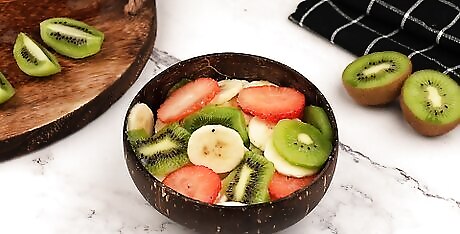
Use kiwi in fruit salad. Kiwi is a unique, beautiful addition to any fruit salad. Slice it into discs or bite-sized pieces, then toss it with your favorite fruits for a bright green element. Here are a few fruit combinations that taste great with kiwi: Tropical fruit salad: toss kiwi pieces with chopped pineapple, mango and bananas. Toss with a squeeze of lime juice. Berry fruit salad: toss kiwi pieces with sliced strawberries, whole raspberries and whole blackberries. Toss with a squeeze of lemon juice. Citrus fruit salad: toss kiwi pieces with mandarin orange slices and chopped grapefruit.
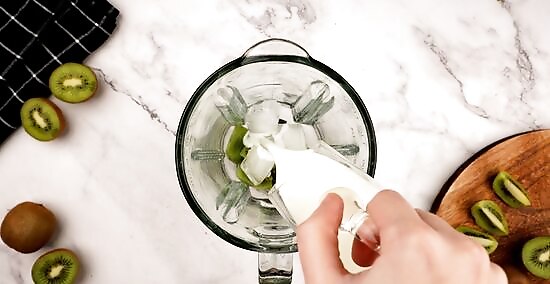
Make a kiwi smoothie. Adding kiwi fruit to a smoothie gives it a nutritious and flavorful boost. Kiwi complements green smoothies in particular, thanks to its bright color. To make a kiwi smoothie, follow these steps: Peel two ripe kiwis. Add them to a blender with 1/2 cup ice, 1 cup of yogurt, 1 small banana, and 1 cup spinach. If you like your smoothies sweet, add 2 tablespoons honey. Blend until completely smooth, then serve.
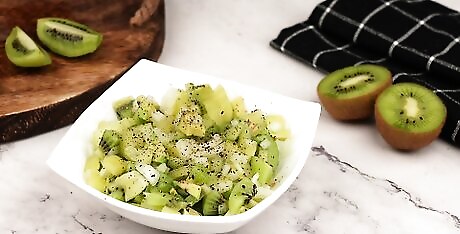
Make kiwi salsa. Like mango, kiwi adds a delicious twist to traditional salsa. Kiwi salsa tastes great with tortilla chips or as a garnish for seafood dishes. Follow these simple steps to make kiwi salsa: Peel and chop two ripe kiwis. Toss the kiwi pieces with 1 chopped avocado, 1/2 diced white onion, and 1 diced yellow bell pepper. Add 1 tablespoon (14.8 ml) lime juice and toss to coat. Season to taste with salt and cayenne pepper.

Try kiwi ice cream. Kiwi ice cream combines the bright flavor of kiwi with the rich, decadent flavors of marshmallow cream and heavy cream. This three-ingredient ice cream is simple to whip up on a hot summer's day. Peel and chop four kiwis. Place them in a food processor along with 1 cup of heavy cream and 6 ounces of marshmallow cream. Process until smooth. Freeze the mixture in your ice cream maker according to the manufacturer's instructions. Store the soft ice cream in your freezer for several hours to harden.
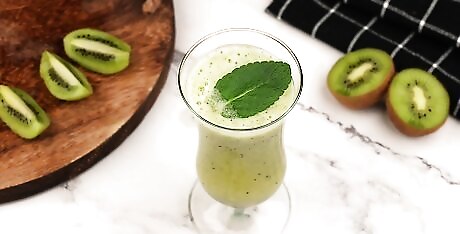
Make kiwi ice juice. Kiwi juice is a simple and healthy recipe for overcoming thirst. To make kiwi juice, follow these steps: Peel off 1 or 2 kiwis and slice into quarters or even smaller pieces. Put all the pieces of kiwis into a blender and add 1 full-sized glass of water into it. Add some mint leaves and 4 or 5 tablespoons of sugar for sweetness into the mixture. Blend until the juice mixes thoroughly, and then serve.















Comments
0 comment